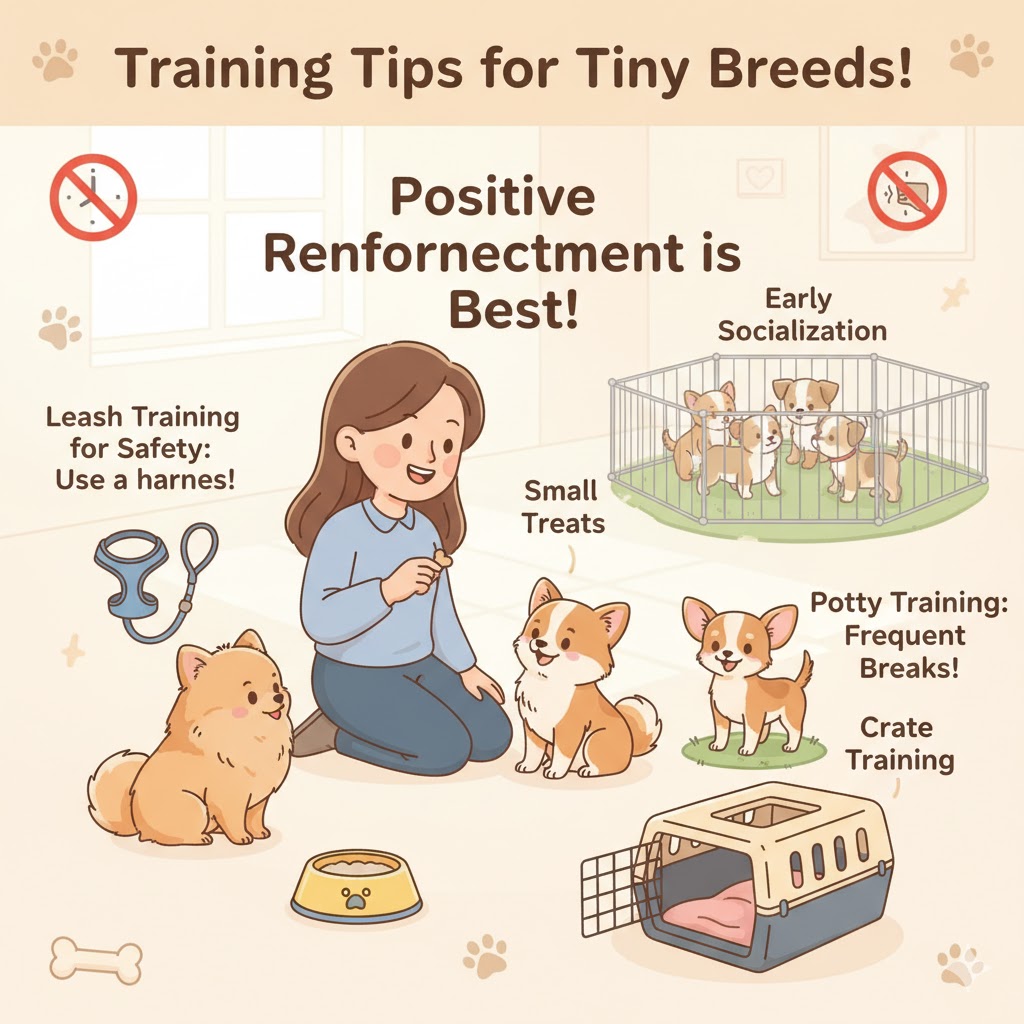
Training a small dog may seem easier because of their size, but anyone who’s had a spirited Chihuahua or a fluffy Pomeranian knows that small dogs come with big personalities. Whether it’s excessive barking, nervousness around strangers, or refusing to walk nicely on a leash — training tiny breeds requires patience, positive reinforcement, and consistency.
In this guide, we’ll explore expert small dog training tips specifically designed for breeds like Chihuahuas, Pomeranians, and other toy-sized pups. You’ll also learn how to make the process smoother with trusted tools and guides available at PetsDogPuppy — your go-to resource for expert puppy care advice, accessories, and training solutions.
Understanding the Mindset of Small Breeds
Before you begin any training, it’s important to understand how small dogs think. Breeds like Chihuahuas and Pomeranians were bred for companionship, not hard labor or guarding duties. They’re intelligent, alert, and sensitive — which means they can learn quickly, but also develop fear-based habits if not trained properly.
Common behavioral traits in tiny breeds include:
- High alertness: They notice everything, often leading to barking.
- Attachment issues: They may become overly clingy or anxious when left alone.
- Confidence imbalance: Some small dogs act overly bold (“small dog syndrome”), while others become timid or fearful.
The key is to balance love with structure — your tiny dog needs both comfort and clear boundaries.
1. Socialization: Building Confidence Early
Socialization is the foundation of good behavior. Many small dogs develop nervousness because they aren’t exposed to enough new experiences in a safe, controlled way.
Tips for Proper Socialization:
- Start early: Introduce your Chihuahua or Pomeranian to new people, gentle dogs, and environments from 8–12 weeks old.
- Use positive associations: Give treats and praise whenever your puppy meets someone new or explores a new space calmly.
- Avoid overwhelming situations: Keep early interactions short and positive. Large crowds or loud noises can scare tiny pups.
- Gradual exposure: Take your puppy on car rides, walks in quiet parks, and short visits to pet-friendly stores.
Well-socialized small dogs are more relaxed, confident, and easier to train in all areas.
2. Crate Training: Creating a Safe Haven
Crate training isn’t just for big dogs — it’s incredibly useful for small breeds, too. A crate helps with housebreaking, gives your puppy a safe retreat, and prevents destructive behavior when unsupervised.
Steps to Crate Train Your Small Dog:
- Choose the right size crate: Your dog should be able to stand, turn, and lie down comfortably — but not too large.
- Make it cozy: Add a soft blanket and a toy to make it feel like home.
- Introduce it slowly: Feed your puppy near or inside the crate to create a positive association.
- Never use the crate as punishment: It should be a happy place, not a “time-out” corner.
- Be consistent: Use the crate regularly for short periods to build comfort and trust.
With time, your tiny dog will see the crate as their own little den — a safe, calming space they love.
3. Leash Manners: Teaching Small Dogs to Walk Nicely
Small dogs often pull or zigzag during walks, partly because they’re curious and easily distracted. Proper leash manners are essential to ensure safety and pleasant walks.
How to Train Good Leash Behavior:
- Use the right gear: A comfortable harness is better than a collar for small dogs — it prevents neck strain.
- Start indoors: Practice walking beside you on a loose leash in a quiet, familiar area.
- Reward often: Give treats for walking calmly and staying by your side.
- Stop and stand still: If your puppy pulls, stop walking. Wait until they return to you, then resume.
- Short, frequent sessions: Keep training sessions brief (5–10 minutes) to avoid frustration.
Leash training builds trust and makes daily walks an enjoyable bonding time for you and your pup.
4. Positive Reinforcement: The Secret to Small Dog Success
Small breeds respond best to positive reinforcement — rewarding desired behaviors instead of punishing mistakes. Chihuahuas and Pomeranians are sensitive and may become fearful with harsh corrections.
Effective Rewards Include:
- Tiny treats or kibble pieces
- Gentle praise in a calm, happy tone
- A favorite toy or belly rub
Avoid:
- Shouting or hitting — this creates fear
- Long scolding sessions — small dogs quickly lose focus
- Inconsistent reactions — confusion leads to bad habits
The goal is to make training fun and rewarding so your dog wants to behave well.
For detailed guides on positive reinforcement techniques and reward-based training plans, check out the expert resources on PetsDogPuppy.
5. Tackling Common Behavioral Challenges
Barking Too Much
Chihuahuas and Pomeranians are known for being vocal. Barking is often caused by boredom, excitement, or fear.
How to Reduce Excessive Barking:
- Teach the “Quiet” command with reward-based training.
- Ignore attention-seeking barking — don’t reward it with eye contact or speech.
- Provide mental stimulation like puzzle toys or short training games.
- Ensure your dog gets enough daily exercise to release energy.
Nervousness or Fear
Small dogs can easily develop anxiety, especially if they’re coddled too much or isolated.
How to Calm an Anxious Dog:
- Keep routines consistent (feeding, walks, bedtime).
- Avoid sudden loud noises and chaotic environments.
- Encourage independence — leave them alone for short periods.
- Use soft background music or a cozy crate space for relaxation.
Potty Training Issues
Tiny breeds have small bladders, so housebreaking can take time.
Helpful Tips:
- Take your puppy out frequently — after meals, naps, and playtime.
- Reward immediately after they potty in the right spot.
- Use puppy pads during the early stages if needed.
- Be patient and consistent — small dogs may take a few extra weeks to master it.
6. Keep Training Fun and Consistent
Small dogs learn best through short, engaging sessions. Aim for 5–10 minutes of focused training, two or three times a day. Repetition and consistency are key — even a few minutes daily make a big difference.
Mix obedience commands with fun tricks like “spin” or “sit pretty” to keep your Chihuahua or Pomeranian mentally stimulated and eager to learn.
7. Explore Trusted Resources at PetsDogPuppy.com
If you want to go deeper into Chihuahua behavior, Pomeranian puppy training, and small dog training tips, visit PetsDogPuppy.
You’ll find:
- Step-by-step puppy training guides
- Product recommendations for training accessories
- Expert health and grooming advice
- Real experiences from other dog owners
Whether you’re looking for the best harness for small dogs, crate training essentials, or behavioral advice, PetsDogPuppy.com offers reliable, research-based insights for every puppy stage.
Final Thoughts
Training tiny breeds like Chihuahuas and Pomeranians takes patience, consistency, and lots of love. These little companions might be small in size, but their energy and loyalty are unmatched. With proper socialization, crate training, positive reinforcement, and good leash manners, your small dog will grow into a confident, well-behaved member of your family.
